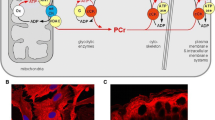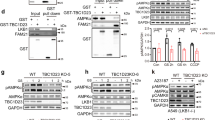Abstract
Creatine kinase (CK) isoenzymes are essential for storing, buffering and intracellular transport of “energy-rich” phosphate compounds in tissues with fluctuating high energy demand such as muscle, brain and other tissues and cells where CK is expressed. In brain and many non-muscle cells, ubiquitous cytosolic “brain-type” BB-CK and ubiquitous mitochondrial CK (uMtCK) act as components of a phosphocreatine shuttle to maintain cellular energy pools and distribute energy flux. To date, still relatively little is known about direct coupling of functional dimeric BB-CK with other partner proteins or enzymes that are important for cell function. Using a global yeast two-hybrid (Y2H) screen with monomeric B-CK as bait and a representative brain cDNA library to search for interaction partners of B-CK with proteins of the brain, we repeatedly identified the cis-Golgi Matrix protein (GM130) as recurrent interacting partner of B-CK. Since HeLa cells also express both BB-CK and GM130, we subsequently used this cellular model system to verify and characterize the BB-CK-GM130 complex by GST-pulldown experiments, as well as by in vivo co-localization studies with confocal microscopy. Using dividing HeLa cells, we report here for the first time that GM130 and BB-CK co-localize specifically in a transient fashion during early prophase of mitosis, when GM130 plays an important role in Golgi fragmentation that starts also at early prophase. These data may shed new light on BB-CK function for energy provision for Golgi-fragmentation that is initiated by cell signalling cascades in the early phases of mitosis.
Similar content being viewed by others
Abbreviations
- B-CK:
-
refers to either the ubiquitous brain-type CK subunit, B-CK cDNA constructs or B-CK bait constructs, whereas BB-CK refers to the functional cytosolic, ubiquitous brain-type CK dimer complex found in vivo
- uMtCK:
-
ubiquitous mitochondrial CK
- GST:
-
Glutathione-S-transferase and Y2H refers to yeast two-hybrid
References
Eppenberger HM, Dawson DM, Kaplan NO. 1967 The comparative enzymology of creatine kinases. I. Isolation and characterization from chicken and rabbit tissues. J Biol Chem 242(2):204–209
Wallimann T, Wyss M, Brdiczka D, Nicolay K, Eppenberger HM. 1992 Intracellular compartmentation, structure and function of creatine kinase isoenzymes in tissues with high and fluctuating energy demands: the ‘phosphocreatine circuit’ for cellular energy homeostasis. Biochem J 281(Pt 1):21–40
Wallimann T, Hemmer W. 1994 Creatine kinase in non-muscle tissues and cells. Mol Cell Biochem 133–134:193–220
Ames A III: CNS energy metabolism as related to function. Brain Res Brain Res Rev 34(1–2): 42–68, 2000
Streijger F, Jost CR, Oerlemans F, Ellenbroek BA, Cools AR, Wieringa B, Van der Zee CE. 2004 Mice lacking the UbCKmit isoform of creatine kinase reveal slower spatial learning acquisition, diminished exploration and habituation, and reduced acoustic startle reflex responses Mol Cell Biochem 256–257(1–2):305–318
Speer O, Neukomm LJ, Murphy RM, Zanolla E, Schlattner U, Henry H, Snow RJ, Wallimann T. 2004 Creatine transporters: a reappraisal Mol Cell Biochem 256–257(1–2):407–424
Brdiczka D. 1994 Function of the outer mitochondrial compartment in regulation of energy metabolism. Biochim Biophys Acta 1187(2):264–269
Friedman DL, Roberts R. 1994 Compartmentation of brain-type creatine kinase and ubiquitous mitochondrial creatine kinase in neurons: evidence for a creatine phosphate energy shuttle in adult rat brain. J Comp Neurol 343(3):500–511
Lim L, Hall C, Leung T, Mahadevan L, Whatley S. 1983 Neurone-specific enolase and creatine phosphokinase are protein components of rat brain synaptic plasma membranes. J Neurochem 41(4):1177–1182
Magistretti PJ, Pellerin L, Rothman DL, Shulman RG. 1999 Energy on demand. Science 283(5401):496–497
Trachtenberg MC, Pollen DA. 1970 Neuroglia: biophysical properties and physiologic function. Science 167(922):1248–1252
Mahajan VB, Pai KS, Lau A, Cunningham DD. 2000 Creatine kinase, an ATP-generating enzyme, is required for thrombin receptor signaling to the cytoskeleton. Proc Natl Acad Sci USA 97(22):12062–12067
Jost CR, Van Der Zee CE, In ‘t Zandt HJ, Oerlemans F, Verheij M, Streijger F, Fransen J, Heerschap A, Cools AR, Wieringa B. 2002 Creatine kinase B-driven energy transfer in the brain is important for habituation and spatial learning behaviour, mossy fibre field size and determination of seizure susceptibility. Eur J Neurosci 15(10):1692–1706
Holtzman D, Togliatti A, Khait I, Jensen F. 1998 Creatine increases survival and suppresses seizures in the hypoxic immature rat. Pediatr Res 44(3):410–414
Prass K, Royl G, Lindauer U, Freyer D, Megow D, Dirnagl U, Stockler-Ipsiroglu G, Wallimann T, Priller J. Improved reperfusion and neuroprotection by creatine in a mouse model of stroke. J Cereb Blood Flow Metab. 2006 Jun 14; [Epub ahead of print]
Hemmer W, Zanolla E, Furter-Graves EM, Eppenberger HM, Wallimann T. 1994 Creatine kinase isoenzymes in chicken cerebellum: specific localization of brain-type creatine kinase in Bergmann glial cells and muscle-type creatine kinase in Purkinje neurons. Eur J Neurosci 6(4):538–549
Barr FA. 1999 A novel Rab6-interacting domain defines a family of Golgi-targeted coiled-coil proteins. Curr Biol 9(7):381–384
Rabouille C, Jokitalo E. 2003 Golgi apparatus partitioning during cell division. Mol Membr Biol 20(2):117–127
Kjer-Nielsen L, Teasdale RD, van Vliet C, Gleeson PA. 1999 A novel Golgi-localisation domain shared by a class of coiled-coil peripheral membrane proteins. Curr Biol 9(7):385–388
Munro S, Nichols BJ. 1999 The GRIP domain – a novel Golgi-targeting domain found in several coiled-coil proteins. Curr Biol 9(7):377–380
Nakamura N, Lowe M, Levine TP, Rabouille C, Warren G. 1997 The vesicle docking protein p115 binds GM130, a cis-Golgi Matrix protein, in a mitotically regulated manner. Cell 89(3):445–455
Barr FA, Puype M, Vandekerckhove J, Warren G. 1997 GRASP65, a protein involved in the stacking of Golgi cisternae. Cell 91(2):253–262
Lowe M, Rabouille C, Nakamura N, Watson R, Jackman M, Jamsa E, Rahman D, Pappin DJ, Warren G. 1998 Cdc2 kinase directly phosphorylates the cis-Golgi matrix protein GM130 and is required for Golgi fragmentation in mitosis. Cell 94(6):783–793
Preisinger C, Short B, De Corte V, Bruyneel E, Haas A, Kopajtich R, Gettemans J, Barr FA. 2004 YSK1 is activated by the Golgi matrix protein GM130 and plays a role in cell migration through its substrate 14-3-3zeta. J Cell Biol 164(7):1009–1020
Cuomo CA, Kirch SA, Gyuris J, Brent R, Oettinger MA. 1994 Rch1, a protein that specifically interacts with the RAG-1 recombination-activating protein. Proc Natl Acad Sci USA 91(13):6156–6160
Serebriiskii IG, Golemis EA. 2000 Uses of lacZ to study gene function: evaluation of beta-galactosidase assays employed in the yeast two-hybrid system. Anal Biochem 285(1):1–15
Kolonin MG, Zhong J, Finley RL. 2000 Interaction mating methods in two-hybrid systems. Methods Enzymol 328:26–46
Slusarewicz P, Nilsson T, Hui N, Watson R, Warren G. 1994 Isolation of a matrix that binds medial Golgi enzymes. J Cell Biol 124(4):405–413
Schlattner U, Reinhart C, Hornemann T, Tokarska-Schlattner M, Wallimann T. 2002 Isoenzyme-directed selection and characterization of anti-creatine kinase single chain Fv antibodies from a human phage display library. Biochim Biophys Acta 1579(2–3):124–132
Stolz M, Wallimann T. 1998 Myofibrillar interaction of cytosolic creatine kinase (CK) isoenzymes: allocation of N-terminal binding epitope in MM-CK and BB-CK. J Cell Sci 111(Pt 9):1207–1216
Williams SK, Spence HJ, Rodgers RR, Ozanne BW, Fitzgerald U, Barnett SC. 2005 Role of Mayven, a kelch-related protein in oligodendrocyte process formation. J Neurosci Res 81(5):622–631
Nakamura N, Rabouille C, Watson R, Nilsson T, Hui N, Slusarewicz P, Kreis TE, Warren G. 1995 Characterization of a cis-Golgi matrix protein, GM130. J Cell Biol 131(6 Pt 2):1715–1726
Lowe M, Gonatas NK, Warren G. 2000 The mitotic phosphorylation cycle of the cis-Golgi matrix protein GM130. J Cell Biol 149(2):341–356
La Terra S, English CN, Hergert P, McEwen BF, Sluder G, Khodjakov A. 2005 The de novo centriole assembly pathway in HeLa cells: cell cycle progression and centriole assembly/maturation. J Cell Biol 168(5):713–722
Zhao J, Schmieg FI, Simmons DT, Molloy GR. 1994 Mouse p53 represses the rat brain creatine kinase gene but activates the rat muscle creatine kinase gene. Mol Cell Biol 14(12):8483–8492
Schlattner U, Mockli N, Speer O, Werner S, Wallimann T. 2002 Creatine kinase, creatine transporter in normal, wounded, and diseased skin. J Invest Dermatol 118(3):416–423
Suginta W, Karoulias N, Aitken A, Ashley RH. 2001 Chloride intracellular channel protein CLIC4 (p64H1) binds directly to brain dynamin I in a complex containing actin, tubulin and 14-3-3 isoforms. Biochem J 359(Pt 1):55–64
Cande WZ. 1983 Creatine kinase role in anaphase chromosome movement. Nature 304(5926):557–558
Lippincott-Schwartz J, Yuan LC, Bonifacino JS, Klausner RD. 1989 Rapid redistribution of Golgi proteins into the ER in cells treated with brefeldin A: evidence for membrane cycling from Golgi to ER. Cell 56(5):801–813
Sutterlin C, Lin CY, Feng Y, Ferris DK, Erikson RL, Malhotra V. 2001 Polo-like kinase is required for the fragmentation of pericentriolar Golgi stacks during mitosis. Proc Natl Acad Sci USA 98(16):9128–9132
Eder M, Schlattner U, Becker A, Wallimann T, Kabsch W, Fritz-Wolf K. 1999 Crystal structure of brain-type creatine kinase at 1.41 A resolution Protein Sci 8(11):2258–2269
Hornemann T, Rutishauser D, Wallimann T. 2000 Why is creatine kinase a dimer? Evidence for cooperativity between the two subunits. Biochim Biophys Acta 1480(1–2):365–373
Sonnichsen B, Lowe M, Levine T, Jamsa E, Dirac-Svejstrup B, Warren G. 1998 A role for giantin in docking COPI vesicles to Golgi membranes. J Cell Biol 140(5):1013–1021
Orci L, Perrelet A, Rothman JE. 1998 Vesicles on strings: morphological evidence for processive transport within the Golgi stack. Proc Natl Acad Sci USA 95(5):2279–2283
Diaz E, Schimmoller F, Pfeffer SR. 1997 A novel Rab9 effector required for endosome-to-TGN transport. J Cell Biol 138(2):283–290
Warren G, Malhotra V. 1998 The organisation of the Golgi apparatus. Curr Opin Cell Biol 10(4):493–498
Mellman I, Simons K. 1992 The Golgi complex: in vitro veritas? Cell 68(5):829–840
Barr FA. 2002 Inheritance of the endoplasmic reticulum and Golgi apparatus. Curr Opin Cell Biol 14(4):496–499
Pelletier L, Stern CA, Pypaert M, Sheff D, Ngo HM, Roper N, He CY, Hu K, Toomre D, Coppens I and others: Golgi biogenesis in Toxoplasma gondii. Nature 418(6897): 548–552, 2002
Uchiyama K, Jokitalo E, Lindman M, Jackman M, Kano F, Murata M, Zhang X, Kondo H. 2003 The localization and phosphorylation of p47 are important for Golgi disassembly–assembly during the cell cycle. J Cell Biol 161(6):1067–1079
Misteli T, Warren G. 1994 COP-coated vesicles are involved in the mitotic fragmentation of Golgi stacks in a cell-free system. J Cell Biol 125(2):269–282
Sohda M, Misumi Y, Yano A, Takami N, Ikehara Y. 1998 Phosphorylation of the vesicle docking protein p115 regulates its association with the Golgi membrane. J Biol Chem 273(9):5385–5388
Jackman M, Firth M, Pines J. 1995 Human cyclins B1 and B2 are localized to strikingly different structures: B1 to microtubules, B2 primarily to the Golgi apparatus. Embo J 14(8):1646–1654
Colanzi A, Deerinck TJ, Ellisman MH, Malhotra V. 2000 A specific activation of the mitogen-activated protein kinase kinase 1 (MEK1) is required for Golgi fragmentation during mitosis. J Cell Biol 149(2):331–339
Saks V, Dzeja P, Schlattner U, Vendelin M, Terzic A, Wallimann T. 2006 Cardiac system bioenergetics: metabolic basis of the Frank-Starling law. J Physiol 571(Pt 2):253–273
Santoro MM, Gaudino G, Marchisio PC. 2003 The MSP receptor regulates alpha6beta4 and alpha3beta1 integrins via 14-3-3 proteins in keratinocyte migration. Dev Cell 5(2):257–271
Tibaldi E, Arrigoni G, Brunati AM, James P, Pinna LA. 2006 Analysis of a sub-proteome which co-purifies with and is phosphorylated by the Golgi casein kinase. Cell Mol Life Sci 63(3):378–389
Acknowledgments
We kindly thank Dr. Francis Barr for generously providing the rat GM130 constructs and Dr. Jean-Paul Steghens for providing the human B-CK cDNA; Tina Thurnherr and Dr. Elisabeth Ehler for critical reading of the manuscript. Uwe Schlattner is acknowledged for advice for the design of the B-CK bait construct and for supervision during the initial phase of this work. We also thank Dr. Ulricke Kutay and the members of our group for helpful discussions. This work was supported by a Swiss National Foundation Grant No. 3100A0–102075.
Author information
Authors and Affiliations
Corresponding author
Rights and permissions
About this article
Cite this article
Bürklen, T.S., Hirschy, A. & Wallimann, T. Brain-type creatine kinase BB-CK interacts with the Golgi Matrix Protein GM130 in early prophase. Mol Cell Biochem 297, 53–64 (2007). https://doi.org/10.1007/s11010-006-9322-4
Received:
Accepted:
Published:
Issue Date:
DOI: https://doi.org/10.1007/s11010-006-9322-4




